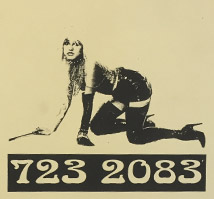Commercial Art in the Public Realm II: Tart Art
This feature first appeared in Eye Magazine Number 34 Winter 1999
Every phonebox from Mayfair to Pimlico and from Paddington to Kings Cross is festooned with vivid cards advertising prostitutes. Stridently competitive in colour and image they are a phenomenon of the eighties and nineties and are virtually unique to London. They would not be there if what my mother used to call ‘ladies of the night’ (although some are gentlemen and others offer a twenty-four-hour service) were allowed, as in other European capitals, to advertise in the Yellow Pages.
As a result therefore of a typically British act of backfiring censorship, a busy folk art has arose with its own chapbook-like style of design and typography and its own verbal code (‘Greek’, ‘TV’, ‘water-sports’, etc.).
The generic card for a long while had been the hastily produced single colour card on cheap stock featuring only robust lettering. This may have its own semiotic niceties as when gothic lettering hints at ancient tortures in mock dungeons or when letraset fancy writing announces the availability of a French Mistress with a touch of class. For the latter a pastel shade of card might be used though the chosen colour of the stock is generally random, many utterances being repeated on different colours. Black on white seems to have been the original scheme of the genre (where is the collector who has the very earliest furtive examples?) but the pastel colours (flesh pink, eau de nil evoking bodies and bathrooms) and heavier duty reds blues and greens soon followed with occasional and rare deep violets. The size quickly became standardised (as if there had been some unwritten controlling legislation) to an average 4” x 5 1/2” from the original visiting-card size notices which merely advertised in a local model/ phone number formula.
Illustrative material was at first largely emblematic, a high heeled lace up boot and a whip carried unequivocal information to reinforce phrases endorsed by generations of use like ‘strict disciplinarian’. Even the seasons were not forgotten when similar ikons could for example be accompanied by a sprig of holly to enhance my favourite couplet
‘Xmas fun/spank my bum’.
When more elaborate drawings made their appearance their style tended towards line-drawing in the mode of those advertising surgical wear and wares in papers such as Exchange & Mart: a prosaically drawn showerhead with falling drops would for example be paired with ‘Golden Showers’ or a naively drawn girl in a maids dress or gym slip would be inserted to raise the hopes of the potential phoner. Ethnic variants (Black Beauty, or even Indian Princess) would receive similar pictorial support.
Until the definitive scholarly monograph explores the true lineages and a firm chronology is established it would be rash to say when the first glossy cards were introduced bearing photographs of the Canadian Student or Swedish Ex-Porn Queen, but their presence was noted in the early nineties in a monochrome form on a white art surface. The de-luxe variant of these with a second colour soon followed and one by one in the mid nineties multi-colour images sprang up with clear photographic vignettes.
At the time of writing the phone boxes of London present a feast of tart-art (as they have come to be known) variations, since no new form has completely ousted its predecessors and the old, now almost homely, typographical versions are exhibited alongside the most recent full colour artworks with computer-assisted graphics (often now so sophisticatedly realised that they are in danger of providing fully satisfactory fantasy food for the fetishist booth lurker).
It is not within the scope of this account to outline the intricate networks which lie behind the phone numbers that purport to put you in direct touch with the Sixteen Year Old Lovely/New To Town (who has to my knowledge been sixteen for at least ten years). These are trails for others hardier than I to follow. Nor can I enumerate the many attempts there have been to legislate against such advertising or the campaigns to surpress it or the promises of councils, governments and police that prostitutes calling cards were ‘about to disappear in a comprehensive clean up’. Suffice it to say that even in Blair’s Britain, the squeakiest and cleanest we have known, a House of Correction in its own right, this pocket of license and anarchy still thrives.

